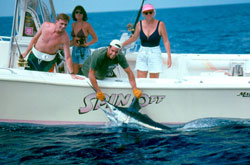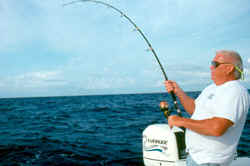
You've been dreaming about catching that one special fish. The scenario has been rehearsed in your mind numerous times and you're confident about making all the right moves when the situation presents itself. Then suddenly, and probably when you least expect it, the moment of truth arrives. Whether it's a mammoth striped bass exploding on a live bunker or a billfish swatting a trolled bait, everything is now playing out at warp speed. With precious little time to think, you're forced into making a quick, instinctive decision on when to set the hook. Do you choke, or rise to the challenge?
Successfully hooking a fish requires assessing its level of aggressiveness, its commitment on the strike and, if free-spooling, the momentum of its run. Sight also comes into play, if you're fortunate enough to see the fish take your bait or lure, and common sense can't be ruled out either. Some of the best anglers miss strikes on occasion, but their overall success in hooking fish stems from an ability to "read" the fish's behavior on the strike and react accordingly. By developing and honing several basic hook-setting skills, you too can become a more proficient fisherman.

Ups and Downs - Anticipating a fish's strike and being able to detect even the slightest tap are indispensable skills when vertical-jigging with lures, spoons, bucktails and soft-plastic baits. These lures are commonly jigged just above the bottom or within a specific portion of the water column. Although strikes do occur on the "upswing," many species attack on the drop, as the lure is falling toward the bottom. Given the slack line created during the lure's descent, coupled with the fact that fish often attack from below, feeling a strike can be difficult. That's why many anglers don't even realize they've just missed a fish, or why they react too late. When vertical jigging, you should be aware of any subtle tap or hesitation in the line during the lure's free-fall. Should anything feel the least bit out of the ordinary, immediately set the hook by taking up line and rearing back on the rod.
Occasionally there's no time to engage the drag. In a fast-strike situation, the hook may have to be initially set by applying firm thumb pressure on the spool of a baitcasting reel, or by cupping the spool of a spinning outfit, and lifting the rod. When the fish begins to run, lower or extend the rod, which creates just enough slack line to engage the drag. Then resume the fight.
Don't Set It - When retrieving a lure or jig horizontally, don't pause on the strike or jerk the rod violently to set the hook. Instead, keep the rod tip close to the water and reel as rapidly as possible when you feel a strike. This technique has three advantages. First, a fast, steady retrieve will out-pace a fish that may have grabbed the lure from behind and swimming toward the boat. Obviously, if the fish strikes while racing away from the boat, the extra resistance will only aid in setting the hook. A second advantage is that a short-striking fish may perceive the sudden pick-up in speed as a startled baitfish running for its life, and come back for another strike. Finally, by keeping the rod tip close to the water and not rearing back, the lure will continue on its original path and remain fair game to the fish that missed it, or a companion. Another light-tackle hook-setting technique is to keep winding on the strike as outlined above and then thumb or cup the reel spool for a split second if the fish "wallowing" in place and trying to shake the hook. This sudden increase in pressure, combined with a few rapid, close-to-the-water rod sweeps, often provides a solid hook-set. However, remember that you'll be flirting dangerously close to the line's breaking point, so it's imperative to know when to release the spool.

Natural Bait Strikes - There's always concern over how long to let a fish run after picking up a natural bait. A lot depends on the target species, the size of the bait, and, of course, the fish's mood. For instance, with fish that tend to engulf baits, such as striped bass, snook, grouper and amberjack, it's often just a matter of dropping the rod tip (for deep-holding fish) or extending the rod (for fish near the surface) on the pick-up, then quickly reeling in slack and setting the hook as the fish begins to run with the bait. Bowing, extending or dipping the rod prior to letting the line come tight often gives the fish enough time to consume a bait without sensing anything unnatural. Sometimes it's the only way to hook a wary or finicky fish, especially those that tend to pick up the bait and drop it.
Use Your Eyes - Watching a fish eat your bait takes the guesswork out of when to set the hook. The scenario can involve dropping back to a billfish, dolphin, striped bass, yellowtail, cobia, and even gray snapper in a chum slick. Depending upon the situation, either extend the rod or free-spool just long enough to watch the bait disappear in the fish's mouth. When it does, take up the slack and strike. Also, remember that your best striking angle will be when the fish is turned sideways to the boat or swimming directly away from it. If it's facing you, there's a greater risk of pulling the bait from its mouth during the strike. Once again, strike the fish with the rod held parallel to the water, not overhead.
Blind Strikes - When you don't have the luxury of watching the fish eat, you have to rely on instinct. As a general rule, always let the fish pick up and move off with the bait. If you feel abbreviated tugs with very little line being pulled off the spool, the fish is likely mouthing or consuming the bait. The moment the line moves off in a steady, continuous fashion, engage the drag, reel rapidly, and strike with several quick rod sweeps (except when using circle hooks).
Trolling Lures - The beauty of offshore trolling lures, which include standard billfish lures, spoons, feathers, and cedar plugs, is that hook-ups are generally instantaneous and foolproof. However, there are times when a fish will strike short or merely follow the lure. In this case, try reeling the lure away from the reluctant fish, which may trigger its attack mode. As the fish closes the gap, reel the lure away from it again by several more feet. This cat-and-mouse game has a way of charging up a fish and provoking an aggressive response. When the fish finally attacks, hold the rod parallel to the water and begin reeling to remove slack line and set the hook.
If the fish strikes but misses the hook, either tease it into striking again or try free-spooling the lure if the fish doesn't immediately reappear in the spread. An aggressive fish will usually hold onto a lure long enough to be hooked. Many anglers troll soft-bodied lures with extremely light drag settings for that very reason. When a fish strikes, it feels no resistance from the light drag and should continue running with the lure. By the time the angler transfers the outfit to the fighting chair, straps in for the battle and engages the drag, the lure should be deep within the fish's mouth. What's more, the fish should also be swimming sideways to or away from the boat, ensuring a solid hook-up. It's a deadly technique that produced an 800-pound blue marlin for me in Costa Rica several years ago.
Another key to successfully hooking up on the troll is not to alter the speed of the boat on the strike. Don't shift into neutral or slam the throttles forward in drag-race fashion. By keeping the boat speed steady for 15 to 30 seconds, you'll help take the stretch out of the monofilament line and drive the hook home. Furthermore, fish won't be frightened or distracted by a sudden change in engine rpm. You'll also increase your chances of hooking another fish on one of the other lines.
The Circle Hook Technique - Many theories on when and how to set the hook have been rendered moot by circle hooks. If you try setting a circle hook, you'll end up empty-handed nearly every time. However, once you learn how to fish with circle hooks, your success rate will soar. Equally important, the chances of gut-hooking the fish will be greatly diminished.
Often touted as the "great equalizer" in modern fishing, circle hooks make it possible for a novice angler to hook nearly as many fish as a seasoned pro. That's because the hook's design requires that the angler let the fish hook itself. As the fish moves off, the line slides to the corner of the fish's mouth, pulling the circle hook from deep within the mouth, stomach or throat and into the corner of the jaw. The hook design then enables it to latch onto the jaw and rotate to complete penetration. Simply hold the rod, or leave it in a holder, and wait for the fish to move off, pull the rod tip down and begin taking line. At this point you can begin winding to remove any stretch and complete the hooking process. Then fight the fish in a normal fashion.

